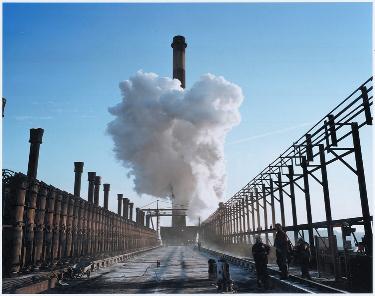Naoya Hatakeyama
dal 26/3/2004 al 8/5/2004
Segnalato da
26/3/2004
Naoya Hatakeyama
L.A. Galerie Lothar Albrecht, Frankfurt
The series 'Atmos' comprises two sets of motifs: views of the vast Rhone delta scenery on the one hand, and shots of the Sollac steelworks on the edge of that natural landscape on the other. The sets consist of eleven photographs each.

ATMOS
The Japanese photographer Naoya Hatakeyama produced his new series, Atmos, in the Camargue region in southern Provence/France in 2003. The series comprises two sets of motifs: views of the vast Rhone delta scenery on the one hand, and shots of the Sollac steelworks on the edge of that natural landscape on the other. The sets consist of eleven photographs each. Hence, views up to the horizon across the flat countryside characterized only by water and the sky, low vegetation and salt deposits, reflections and colorings in the sky, stand vis-Ã -vis images of enormous rising clouds of steam, red-hot metal, looming smokestacks and powerful machines.
Atmos picks up the thread from earlier works of Hatakeyama. In the Blast series (since 1995) he had captured with his camera those moments during blastings when the immense force of the blast makes rocks shatter as if they were clouds. Also featured in recent works of his were mountains used as a source of limestone being removed bit by bit and acquiring completely new, artificial shapes in the process (Lime Hills [Quarry Series] , 1986-91); deep concrete pipe drains in Tokyo carrying sewage in all imaginable shades and colors (River Series, 1993-94); views of rampantly growing big cities; and the caves of sewerages with the very bizarre organisms that can be found there. Hatakeyama transferred all of these subjects to skillfully composed pictures of great aesthetic appeal.
The photographs in the Atmos series are again composed with the meticulousness typical of Hatakeyama. In each of the views across the Camargue scenery, the horizon is situated at the same level of the picture, dividing it in the middle. This unspoiled country, however, a reservation of nature where plants and animals exist in a vast and strangely empty zone marked by the earth, the sky and the sea, stands apart from the sites he had dealt with before, places that were harmed and transfigured by human civilization. Hatakeyama describes his encounter with the Camargue landscape as an almost mythical experience:
In the Camargue, the horizon was as if it had been sliced with a razor around the entire 360-degree circumference. Above, there was only sky. Below, the asphalt road. The water of the sea, lakes marshes. There was mud, sand, salt, low-standing plants. In the lagoons, flamingos dunked for food.
In Hatakeyama's photographs, nature appears newly created, as if heaven and earth and the sea were only just divided and still unpopulated by humanity. The cloud of steam rising at the edge of the delta in regular intervals looks like a sign or promise:
From the horizon far to the east, I could see a small cloud rise now and again. From any spot in the broad expanse of the Camargue, that small cloud could be seen rising, lit by the sun and shining bright white. The cloud rose every few minutes from a steel factory at the eastern edge of the delta.
At the steelworks, subject of the second part of the series, elemental forces are at work. Water rises in huge clouds of steam, melted metal glows and bubbles. The gigantic structures of the factory seem to be the work of Titans. In Hatakeyama's pictures, industrial steel production is rendered a natural phenomenon, comparable to a volcanic eruption. Both in his photographs and the accompanying text Hatakeyama describes how he experienced the fundamental forces of the elements. They which have shaped the natural landscape now collide again in the steelworks. Hatakeyama, who witnesses this powerful clash, describes the experience as an act of reconciliation; he also explains the title of the new series:
The etymology of "atmosphere" is the ancient Greek words for vapor (atmos) and sphere (sphaira). Once I learned this, the air that filled the Camargue and the steam from the steel factory seemed to fuse into one before my eyes. It no longer felt strange to see signs of humanity in the sky and the land, nor to sense nature in the cloud of steam from the factory. And I began to feel that it would no longer be possible to draw a clear line at the border between nature and the artificial.
L.A.Galerie Lothar Albrecht
Domstraße 6
D-60311 Frankfurt
Tue-Fri 12.00 -19.00 Sat 11.00 -16.00
Tel +49 +69 28 86 87 Fax +49 +69 28 09 1



